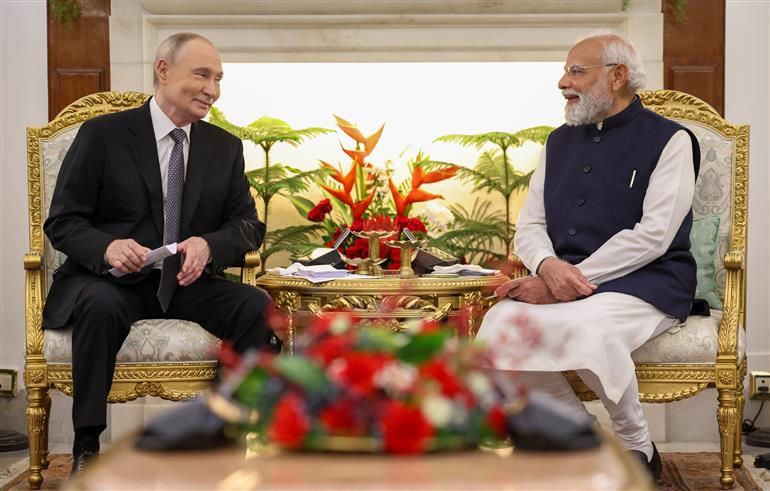India Russia: Future Trajectory of Military Technical Cooperation
- Security Risks Research
- Nov 23, 2023
- 4 min read

Russia or Soviet Union has been India’s strategic partner for over six decades now. As a result of this close relationship as well as a period of hiatus by the West with India, Russia has been a major supplier of defence equipment ranging from tanks to artillery guns, combat fighters, helicopters and submarines. Not to mention an aircraft carrier.
There is a popular perception that given that Russia is a ‘declining’ Great Power, India needs to rebalance relations by proximity to the U.S. implied is also a shift in the defence dependency from Russian to Western manufacturers and equipment. Such a shift is already underway.
Does this imply that the future trajectory of military technical cooperation between Russia and India is likely to result in a terminal decline.
Far from it, India is expected to remain dependent on Russia for military supplies of weapons and equipment and more so sustaining and upgrading the present platforms with the Indian military for at least three decades if not more.
The reasons for the same are not far to seek.
Despite being a declining Great Power Russia will remain an influential pole if not more based on its military and nuclear capability, energy and mineral resources and the ability of the Russian people for revival as they have done so many times in recent history from the Great Revolution of 1919 Post Second World War and after breakup of the Soviet Union.
How Russia emerges from the War in Ukraine remains important apart from the political structure that emerges in Kremlin in a post Putin World? In case the Russian obstinacy to pursue the perilous course of military operations in Ukraine which is sucking away military industry and making it dependent on pariah states as North Korea and Iran is sustained for a long period, indeed there are challenges. The longer the War in Ukraine is pursued the greater will be the damage to overall Russian military as well as comprehensive national power.
An early end – implying in the next one year or so may see the road for revival.
Nevertheless, coming to the main theme of this report- trajectory of India Russia miliary technical cooperation. Some tangibles may provide the answer.
Indian Air Force fleet of combat fighters is expected to comprise Russian origin 272 Su 30 MKI with 12 fighters now on order with the Hindustan Aeronautics Limited.
An upgrade is also planned for the fleet which would entail cooperation and technical assistance from Russia.
The new order for the 12 Sukhoi fighters comes days after India has placed another order directly on a Russian company for Igla a short range air defense missiles with a domestic production component.
Replacement of the Su 30 MKI in terms of numbers for the Indian Air Force is unlikely to be at least before three decades even if the much vaunted 114 Medium Multi Role Fighter aircraft process is dusted off from the musty corridors of the Ministry of Defence.
Rightly so India is depending more on the Light Combat Aircraft (LCA) programme of indigenous fighters with upgraded versions for equipping the Indian Air Force including the AMCA – a fifth generation fighter in the making. These programs are unlikely to fully fructify till another two decades or so, till then and beyond Russian fighters will remain the main stay.
Coming on to the rotary wing transport fleet, Indian Air Force has as per Flight Global 2023 holds 222 Mi 17 helicopters of varied versions.
While the endeavour is to replace these with the native Dhruv Advanced Light Helicopters the process is expected to be slow given many technical challenges that continue to be faced in operations of this fleet by the Indian Air Force and the Army.
Coming on to the fighting component of the Indian Army.
The Indian armoured and mechanized formations are mainly equipped with the T 72/T 90 tanks and BMP 2 Infantry Combat Vehicles of Indian origin.
As of now there is no substitute for the tanks even in the development stage and same is the case with the ICVs. The much-vaunted Future Ready Combat Vehicle and Future Infantry Combat Vehicle programmes are once again languishing for more than a decade.
Much is being talked about of co-development and co production of the Stryker IFV by India and the US after the recent 2 + 2 Dialogue in Delhi in November.
How can a IFV which has been introduced into the US Army in the early 2000 be co-developed in India defies logic.
Instead of shooting down the proposal, Indian Ministry of Defence has placed the ball in the court of the Indian Army. Hopefully the Army will see through a vehicle which was developed as a medium IFV between the heavier Bradley and the lighter Humvee and a wheeled one at that which may not find in the scheme of things.
Clearly the dependence on Russian tanks and IFVs is expected to continue for decades ahead.
Just four major platform systems – Su 30 MKI, the Mi 17, T72/90 and BMP 2 programmes of Indo Russia collaboration demonstrate that the trajectory of military technical cooperation remains on a steady path for decades ahead.
This is not to say that all is hunky dory with Russian development of military programmes or industry and while India needs to continue to look at alternatives for indigenous development and manufacturing with foreign collaboration, talking down Russia in strategic or military terms may not be prudent.



Comments